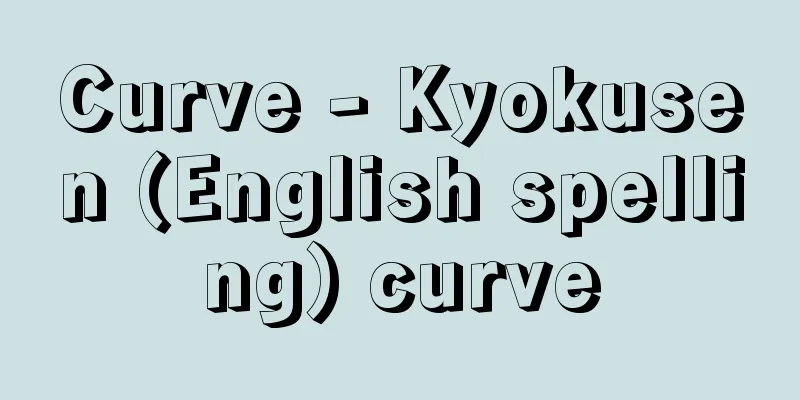Curve - Kyokusen (English spelling) curve

|
A curve or continuous curve is a point on a plane or in space whose coordinates are a continuous function of a real variable t. A curve in a plane is called a plane curve, and the equation The curve is also A plane curve may also be given by y = u(x) or in polar coordinates by r = v(θ). In what follows, we will mainly consider plane curves. For information on individual curves such as "asteroid," "cardioid," "clothoid," "conchoid," "cycloid," "sprint line," "tractrix," "spiral," and "limacon," please refer to the respective entries. [Osamu Takenouchi] Smooth curves In the plane curve x = f(t) and y = g(t), when f(t) and g(t) have derivatives and are continuous, the curve is called a smooth curve. The vector (f'(t), g'(t)) with f'(t) and g'(t) as components is called the tangent vector. A smooth curve is a curve whose tangent vector changes continuously. A tangent vector is a vector that is connected between two nearby points on a curve. [Osamu Takenouchi] Curve Length When there is a curve connecting two points A and B, there are many points on the curve between A and B in order. A smooth curve has a length, which is:
When the equation of a curve is given, tracing the outline of the curve is called tracing the curve. To do this, it is useful to investigate the range in which the curve exists, singular points, asymptote, etc. A curve whose ends are connected, such as a circle, is called a closed curve. There are also closed curves that intersect with themselves, such as the lemniscate. A closed curve that does not intersect with itself is called a simple closed curve, or a Jordan closed curve. Jordan proved the following (1893): "A simple closed curve in a plane divides the plane into two parts, inside and outside, and no point inside can be connected to a point outside without intersecting with the curve." This is called Jordan's curve theorem. The content is common sense, but it is a difficult theorem to prove mathematically. [Osamu Takenouchi] "Various Curves" by Minoru Kurita (1966, Kyoritsu Publishing) [References] | | | | | | | | |©Shogakukan "> Curve length and closed curves Source: Shogakukan Encyclopedia Nipponica About Encyclopedia Nipponica Information | Legend |
|
平面、あるいは空間内で、その点の座標が一つの実変数tの連続関数となっているものを曲線、または連続曲線という。平面内の曲線を平面曲線といい、方程式 曲線はまた、 平面曲線はまた、y=u(x)あるいは極座標によってr=v(θ)で与えられることもある。以下では、おもに平面曲線を考える。 「アステロイド」「カージオイド」「クロソイド」「コンコイド」「サイクロイド」「疾走線(しっそうせん)」「トラクトリックス」「螺線(らせん)」「リマソン」などの個々の曲線については、各項目を参照されたい。 [竹之内脩] 滑らかな曲線平面曲線x=f(t), y=g(t)において、f(t), g(t)が導関数を有し、かつそれらが連続であるとき、この曲線を滑らかな曲線という。そして、f′(t), g′(t)を成分とするベクトル(f′(t), g′(t))を接ベクトルという。滑らかな曲線とは、接ベクトルが連続的に変わっていく曲線、という意味である。接ベクトルは、曲線上の近い2点 [竹之内脩] 曲線の長さ2点A、Bを結ぶ曲線があるとき、この曲線上でA、Bの間に順に数多くの点 滑らかな曲線は長さを有し、その長さは次のようになる。
曲線の式が与えられたとき、この曲線の概形を描くことを、曲線の追跡という。このためには、曲線の存在する範囲や、特異点、漸近線(ぜんきんせん)などを調べるとよい。 円のように両端がつながっている曲線を閉曲線という。レムニスケートのように自分自身と交わりをもつ閉曲線もある。自分自身と交わりをもたない閉曲線を単純閉曲線、あるいはジョルダン閉曲線という。ジョルダンは次のことを示した(1893)。「平面内の単純閉曲線は、平面を内部と外部の二つの部分に分け、内部の点と外部の点は、この曲線と交わることなしには結べない」。これをジョルダンの曲線定理という。内容は常識的であるが、数学的に証明しようとするとむずかしい定理である。 [竹之内脩] 『栗田稔著『いろいろな曲線』(1966・共立出版)』 [参照項目] | | | | | | | | |©Shogakukan"> 曲線の長さと閉曲線 出典 小学館 日本大百科全書(ニッポニカ)日本大百科全書(ニッポニカ)について 情報 | 凡例 |
>>: Oksongni Historic Site - Oksongni Historic Site (English)
Recommend
Oxalic acid (oxalic acid)
The simplest of the dicarboxylic acids with two ca...
Okinawa Club
...Therefore, the necessity for suffrage became t...
Arikbüge (English spelling)
?-1266 A man who competed with Kublai Khan for the...
Chryselephantinos (English spelling)
An ancient Greek statue made of gold and ivory. It...
Kubiki [village] - Kubiki
A village in Nakakubiki County, southern Niigata P...
Kanze Sakondayu's Quiet Life - Kanze Sakondayu's Quiet Life
...It is said that the reason was a reaction agai...
Dakota
...the Dakota are a people who originally lived i...
Abnormal breasts
(1) Milk that is not mature, such as colostrum and...
Kamchadaly
...Therefore, the languages spoken are Itelmen ...
Snow leopard (Snow leopard) - Snow leopard (English spelling)
A mammal of the Felidae family in the carnivora or...
Galapagos Ridge
The chemical synthesis of sulfur bacteria is the ...
Summer person
…So what was this kind of ethnic group called bef...
McKim, CF (English spelling) McKimCF
…The most influential architectural firm in the l...
Inspector - Azechi
〘Noun〙① A local administrative oversight body esta...
HDL - HDL
Hardware Description Language : An artificial lang...



![Misato [village] - Misato](/upload/images/67ccf02cc8e35.webp)





